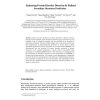Free Online Productivity Tools
i2Speak
i2Symbol
i2OCR
iTex2Img
iWeb2Print
iWeb2Shot
i2Type
iPdf2Split
iPdf2Merge
i2Bopomofo
i2Arabic
i2Style
i2Image
i2PDF
iLatex2Rtf
Sci2ools
105
Voted
BIRD
2007
Springer
2007
Springer
Enhancing Protein Disorder Detection by Refined Secondary Structure Prediction
More and more proteins have been observed to display functions through intrinsic disorder. Such structurally flexible regions are shown to play important roles in biological processes and are estimated to be abundant in eukaryotic proteomes. Previous studies largely use evolutionary information and combinations of physicochemical properties of amino acids to detect disordered regions from primary sequences. In our recent work DisPSSMP, it is demonstrated that the accuracy of protein disorder prediction is greatly improved if the disorder propensity of amino acids is considered when generating the condensed PSSM features. This work aims to investigate how the information of secondary structure can be incorporated in DisPSSMP to enhance the predicting power. We propose a new representation of secondary structure information and compare it with three naïve representations that have been discussed or employed in some related works. The experimental results reveal that the refined informat...
Related Content
| Added | 07 Jun 2010 |
| Updated | 07 Jun 2010 |
| Type | Conference |
| Year | 2007 |
| Where | BIRD |
| Authors | Chung-Tsai Su, Tong-Ming Hsu, Chien-Yu Chen, Yu-Yen Ou, Yen-Jen Oyang |
Comments (0)

